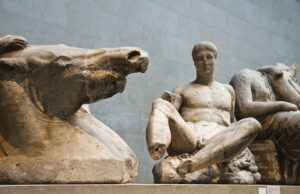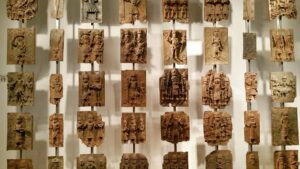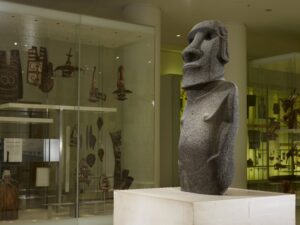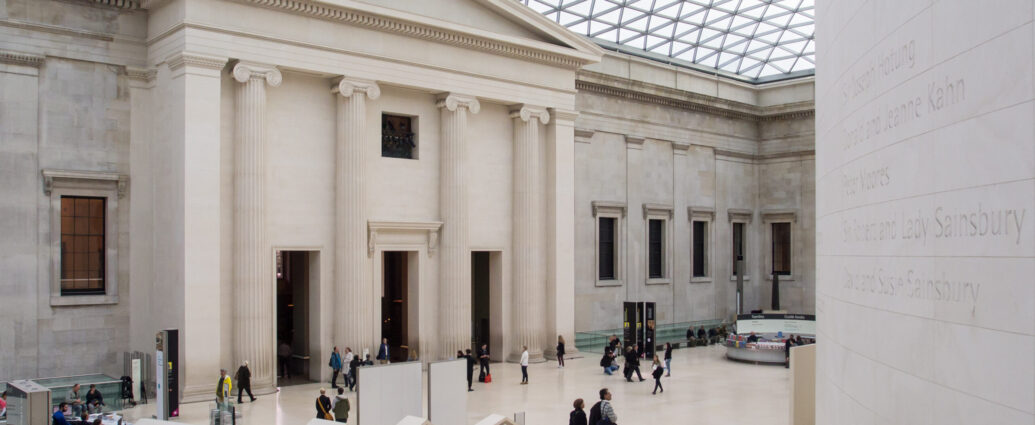Lauren Hope Sanderson
The latest theft scandal at the British Museum has renewed calls for the repatriation of looted artefacts.
Theft scandal at the British Museum
An institution infamous for refusing to return stolen artefacts has become the victim, rather than the perpetrator, of theft.
Close to 2,000 artefacts are believed to have been stolen from the British Museum by senior curator Peter Higgs. The museum has said that items from its collections, including “gold jewellery and gems of semi-precious stones and glass dating from the 15th century BC to the 19th century AD” are “missing, stolen or damaged.”
An antiquities expert reportedly told museum officials three years ago that artefacts were being offered for sale on eBay. Following an investigation, the British Museum swiftly concluded that the objects concerned were accounted for and there was “no suggestion of any wrongdoing on behalf of any member of museum staff.”
“Is this the nail in the coffin for the British Museum’s argument against cultural restitution?”
A museum source told The Daily Telegraph that the directorate’s handling of the case has been “negligent and incompetent” and that evidence presented to them had been ignored. It now appears increasingly likely that the British Museum may never know exactly what has been stolen, due to poor cataloguing practices and gaps in its inventory, The Telegraph reports. “It’s chaos down here,” was the now-infamous admission from Higgs, speaking to The Times in 2002.
Speaking to The Economist, Christos Tsirogiannis, who heads the Working Group Illicit Antiquities Trafficking of the Unesco Chair on Threats to Cultural Heritage, stated that the British Museum theft is “probably the worst case [of antiquities trafficking] so far. … No one expects that to happen in a museum.”
Hartwig Fischer, the museum’s director, has resigned with immediate effect in the wake of the scandal.
Historical repatriation controversies
While the British Museum is one of the largest and best-known museums in the world, housing 8 million artefacts, it is no stranger to controversy. Most notably, the museum has been subject to claims that it operates through colonial violence.
The institution has spent decades at the centre of multiple restitution debates over contested artefacts within its collection, including the Parthenon sculptures, the Benin Bronzes and the Ethiopian Tabot. In recent years, countries including Greece, Egypt and Nigeria have requested the repatriation of relics housed in the British Museum.

One of the longest-running controversies surrounding the collection concerns the 2,500-year-old Parthenon sculptures, also known as the Elgin Marbles. While the sculptures originate from the temple of Athena on the Acropolis in Athens, they have become representative of colonial collections held in Britain.
The sculptures were acquired by Scottish nobleman Lord Elgin, who removed them from the ancient Acropolis in 1801 and sold them to the British government in 1816, under dubious legal circumstances.
Greek politicians have made repeated requests to the British Museum for repatriation. However, the museum maintains that their acquisition was a legal act of preservation, and that the institution is the most qualified caretaker of the marbles.
The museum also houses over 900 brass and bronze sculptures and plaques from the West African Kingdom of Benin, dating as far back as the 16th century, which were looted in 1897 by British forces. Around 90 per cent of sub-Saharan Africa’s cultural heritage is estimated to be located outside Africa, as a result of conquest, plunder, theft, and colonisation, as well as legitimate trade and exchange.

The Benin Bronzes have been the subject of numerous books in recent years, such as Blood and Bronze (2021) by Paddy Docherty and Loot: Britain and the Benin Bronzes (2021) by Barnaby Phillips.
The British Museum also reports that it has over 6,000 human remains in its collection, which it says are “managed in a way that protects the collection for the benefit of present and future generations.”
Responses to the British Museum’s theft scandal
The British Museum acknowledges the repatriation debate surrounding items within its collection and lists “contested objects” on its website, stating the historical circumstances of their acquisition and the status of the discussions regarding their retention. The website states: “The Museum’s aim is to hold a collection representative of world cultures and to ensure that the collection is housed in safety, conserved, curated, researched and exhibited.”
Its leadership has repeatedly defended its collection against restitution claims by arguing that the museum is specially capable of conserving and protecting artefacts.
“…a single institution is accumulating items beyond its capacity to research, conserve, and exhibit them.”
Museum trustees and government officials have also previously cited the British Museum Act of 1963 as grounds to deny repatriation requests. The law prohibits the institution from returning any object in the collection unless it is a duplicate, physically damaged or “unfit to be retained in the collection” and no longer of public interest.
But, if the British Museum’s arguments against repatriation rest largely on the premise that they are trusted custodians of disputed cultural heritage objects, could this recent theft scandal be the nail in the coffin for the museum’s opposition to cultural restitution?

This is the stance taken by Greece’s culture minister Lina Mendoni in her scathing response to the scandal: “The thefts by the responsible curator, but also the proud silence of the leaders who neither take care of their collections nor implement the appropriate security measures, proves that the ‘hospitality’ provided to the Parthenon marbles at the British Museum has always been flawed, incomplete, and problematic.”
Nor is this the first time that the museum’s ability to care for its collection has been under question. In 2018, images of water leaking into the Greek galleries were circulated across Greek media. Mendoni later said in a statement that the “abandonment shown in the pictures from the British Museum reinforces Greece’s rightful demand for the sculptures’ permanent return to Athens and their reunification with the Parthenon.”
British Museum’s cataloguing failures enabled theft
The revelation that many of the missing items were never fully catalogued in the British Museum’s collection database has opened the institution up to criticisms that the actions of a single opportunist were facilitated by systemic failures.
In fact, it is now estimated that almost half of the museum’s vast collection has not been catalogued — millions of artefacts languish in storage, barely known to the institution that houses them, and entirely unknown to curators, researchers, and the public.
Curator and author of The Brutish Museums (2020) Dan Hicks has cited inadequate funding and the museum leadership’s strategic prioritisation of temporary exhibitions, at the expense of administrative duties, as reasons for the failure to catalogue items in the collection.
“What exactly is the value of hoarding such an immense collection in a handful of ‘great’ institutions?”
However, incomplete records are not all that uncommon in cultural heritage institutions.
Speaking to Artnet News, art theft expert and author Anthony Amore explained: “If it takes just one hour to identify, handle, photograph, and digitize a collection piece for cataloguing, and you have 8 million pieces, it would take a team of four 685 years to complete the catalogue if they work non-stop, eight hours a day, seven days per week.
“I’m not excusing the British Museum, but my goal is to give context when people sit aghast that the collection wasn’t photographed,” Amore said.
While the British Museum’s incomplete catalogue may not be unprecedented, it does undermine the museum’s claims for both the safety of its collections and the public’s right to access its cultural heritage.
Balancing preservation and access
Only one per cent of the museum’s holdings are on display at any one time. With the knowledge that 99 per cent of the collection is not only hidden from public view, but inaccessible through the museum’s catalogue, it appears less like a public resource and more like a private archive.
The museum’s failure to list their complete collection makes it easy for missing items to go unnoticed, but it also presents a further barrier to future repatriation demands — after all, you cannot demand the return of artefacts if you don’t know where they are.
“It’s very important that we get away from a cozy world of museum curators choosing to share information with each other, and it being available for anyone who has an interest in the matter,” writes Barnaby Phillips.

It begs the question: what exactly is the value of hoarding such an immense collection in a handful of ‘great’ institutions? Perhaps, to display an all-encompassing view of the world’s material heritage, or to sufficiently conserve and protect the collection for the benefit of visitors and academic researchers.
Yet, this is clearly not the case. Instead, a single institution is accumulating items beyond its capacity to research, conserve, and exhibit them.
The future of repatriation
Despite concerns about the museum’s ability to protect its collection and the current state of public trust in the institution, Britain appears to have no plans to return the British Museum’s contested objects, or to amend the British Museum Act. In March this year, Rishi Sunak said that the government does not intend to return the Parthenon marbles to Greece.
Even so, their repatriation would not be without precedent.
In 2017, French President Emmanuel Macron acknowledged that there is “no valid, lasting and unconditional justification” for African artwork taken during the colonial period to be permanently held in Europe. Four years later, 26 Benin treasures that had been looted by French forces in 1892 were returned to the former-French colony.
In February this year, Macron announced a bill to streamline the process of repatriation, adding that he hoped the law would contribute to a wider effort by European countries to return looted artworks to their places of origin.
The question now lingers: Will the recent theft scandal force the British Museum to embrace the initiative for repatriation?
READ NEXT:
-
NIGERIA WELCOMES UK’S MOVE TO RETURN STOLEN ARTEFACTS
-
WHY I WILL NEVER RETURN TO THE VICTORIA AND ALBERT MUSEUM OR THE BRITISH MUSEUM
-
REVIEW: WHY ‘THE STORY OF ART WITHOUT MEN’ DESERVES A SPACE ON YOUR BOOKSHELF
Featured image courtesy of Ed Webster via Flickr. No changes have been made to this image. Image license found here.

